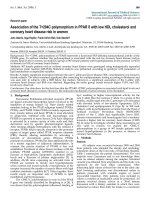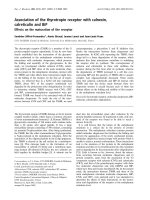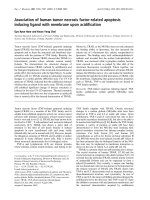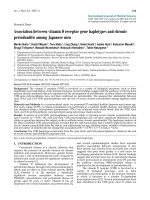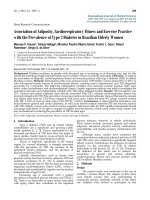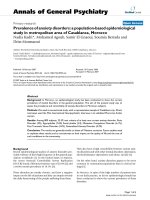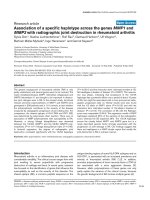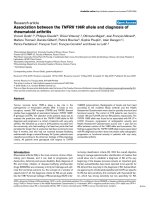Báo cáo y học: "Association of the D repeat polymorphism in the ASPN gene with developmental dysplasia of the hip: a case-control study in Han Chinese" potx
Bạn đang xem bản rút gọn của tài liệu. Xem và tải ngay bản đầy đủ của tài liệu tại đây (197.91 KB, 5 trang )
RESEARCH ARTICLE Open Access
Association of the D repeat polymorphism in the
ASPN gene with developmental dysplasia of the
hip: a case-control study in Han Chinese
Dongquan Shi
1,2†
, Jin Dai
1,2†
, Pengsheng Zhu
3
, Jianghui Qin
1
, Lunqing Zhu
1
, Hongtao Zhu
3
, Baocheng Zhao
3
,
Xusheng Qiu
1
, Zhihong Xu
1
, Dongyang Chen
1
, Long Yi
4
, Shiro Ikegawa
5
, Qing Jiang
1,2*
Abstract
Introduction: Developmental dysplasia of the hip (DDH) is a common skeletal disease, which is characterized by
abnormal seating of the femoral head in the acetabulum. Genetic factors play a considerable role in the etiology
of DDH. Asporin (ASPN) is an ECM protein which can bind to TGF-b1 and sequentially inhibit TGF-b/Smad
signaling. A functional aspartic acid (D) repeat polymorphism of ASPN was first described as an osteoarthritis-
associated polymorphism. As TGF- b is well known as an important regulator in the development of skeletal
components, ASPN may also be involved in the etiology of DDH. Our objective is to evaluate whether the D repeat
polymorphism of ASPN is associated with DDH in Han Chinese.
Methods: The D repeat polymorphism was genotyped in 370 DDH patients and 445 control subjects, and the
allelic association of the D repeat was examined.
Results: From D11 to D18, eight alleles were identified. D13 allele is the most common allele both in control and
DDH groups, the frequencies are 67.3% and 58.1% respectively. In the DDH group, a significantly higher frequency
of the D14 allele and significantly lower frequency of D13 was observed. The association of D14 and D13 was
found in both females and males after stratification by gender. There was no significant difference in any other
alleles we examined.
Conclusions: Our results show an obvious association between the D repeat polymorphism of ASPN and DDH. It
indicates that ASPN is an important regulator in the etiology of DDH.
Introduction
Developmental dysplasia of the hip (DDH; MIM
142700) is a common skeletal disease, which is chara c-
terized by abnormal seating of the femoral head in the
acetabulum [1]. The i ncidence of DDH va ries from 1
per 1,000 to 18.4 per 1,000 in the Caucasian population,
and in the Chinese the incidence of DDH is about 4 per
1,000 [1,2]. DDH could lead to early onset of hip
osteoarthritis because of increased contact pressure
between the acetabulum and femoral head [3-5]. Shal-
low acetabulum and lax capsule were considered to be
the main causes of DDH [6,7]. Several family studies
indicated that a considerable genetic c omponent played
an important role in the etio logy of DDH [8-10].
A genome-wide screening from a large four-generation
Japanese family of acetabula r dysplasia ha d revealed a
linkage between DDH and a specific region at chromo-
some 13 [11]. We had detected a definite association
between a functional SNP in GDF5 and DDH by a case-
control study in the Chinese population, and this asso-
ciation was also found in Caucasians [12,13].
Asporin (ASPN) is an ECM protein which belongs to
the family of small leucine-rich repeat proteins [14].
Previous studies indicated that ASPN could bind to
TGF-b1 and block its interaction with the TGF-b type
II receptor, then sequentially inhibit the TGF-b/Smad
signaling and TGF-b1 induced chondrogenesis [15,16].
* Correspondence:
† Contributed equally
1
The Center of Diagnosis and Treatment for Joint Disease, Drum Tower
Hospital Affiliated to Medical School of Nanjing University, Zhongshan Road
321, Nanjing 210008, Jiangsu, PR China
Full list of author information is available at the end of the article
Shi et al. Arthritis Research & Therapy 2011, 13:R27
/>© 2011 Shi et al.; licensee BioMed Central Ltd. This is an open access article distributed under the terms of the Creative Commons
Attribution License ( which permits unrestricted use, distri bution, and reproduction in
any medium, provided the original work is properly cited.
TGF-b1 was a crucial regulator for the perichondrial
cells and fibroblast cells in tendons. Binding to TGF-b1
may also inhibit perichondrium dependent skeletal
development as well as development of tendons and
ligaments [17,18]. ASPN can also bind to (bone mor-
phogenetic protein 2) BMP2 and inhibit BMP/Smad sig -
naling [19,20]. BMP2 is another growth factor of the
TGF-b family which plays a general role in differentia-
tion and proliferation of perichondrial cells and osteo-
blast [21,22].
Recently, an aspartic acid repeat polymorphism of
ASPN was first described as an osteoarthritis-associated
polymorphism. The D14 allele of ASPN was over-repre-
sented in osteoarthritis subjects, and D14 allele showed
greater inhibition of TGF-b 1 activity than the common
allele, D13 [15]. This association was replicated in differ-
ent populations and confirmed by meta-analysis
although some studies denied this association [23-29].
This polymorphism was also identified to be associated
with lumbar-disc degeneration and the outcome of
rheumatoid arthritis [30,31].
As this polymorphism showed definite associations
with various skeletal diseases [23-31], D14 allele and
D13 allele of this polymorp hism exhibited a remarkable
difference in blocking TGF-b/Smad signaling [15]. W e
suspected that this polymorphism may also play a pivo-
tal role in the etiology and pathogenesis of DDH. To
evaluate the possible association, we conducted a case-
control study on ASPN with DDH in the Chinese Han
population and found a compelling association between
ASPN and DDH.
Materials and methods
Subjects
A total of 756 subjects were studied. Of t hese, 370
patients (313 females and 57 males) were enrolled at the
Center of Diagnosis and Treatment for DDH, Kang’ai
Hospital, while 445 healthy control subjects (290 females
and 155 males) were enrolled at the Physical Examina-
tion Center, Drum Tower Hospital, affiliated to the
Medical School of Nanjing University. All subjects stu-
died in the study were Chinese Han living in and
around Nanjing. No subjects dropped out during the
process of the study. The study was approved by the
ethical committee o f the participating institutions, and
informed consent was obtained from all subjects.
Patients were diagnosed by expert medical examination
with radiographic evidence, and they all suffered from
unilateral or bilateral DDH. Severity of DDH was
defined from mild instability of the femoral head with
slight capsular laxity, through moderate lateral displace-
ment of the femoral head, without loss of contact of the
head with the acetabulum, up to complete dislocation of
the femoral head from the acetabulum [32]. Control
subjects were identified by detailed inquiry of history
and physical examination, and they never had any his-
tory or symptoms of DDH. Subjects with any systemic
syndrome were excluded from this study. The ages of
patients and controls (mean ± standard deviation (SD))
were 21.3 ± 12.2 (range, 2 to 51) months and 57.5 ±
11.9 (range, 40 to 97) years, respectively. The ratio of
female to male was about 6:1 in these cases.
Genotyping
Genomic DNA was extracted from peripheral blood
using the Chelex-100 method or from buccal swabs
using the DNA IQ System (Promega, Madison, WI,
USA) according to the manufacturer’s instructions [33].
DNA was genotyped for the ASPN microsatellite encod-
ing the D repeat polymorph ism after PCR amplification,
the primers and thermal conditions were described
before [23]. PCR products with 2 μLSTR2×Loading
Solution (Promega) were loaded onto 6% denaturing
polyacrylamide gel (BIO-RAD Sequi-Gen GT System 38
× 30 cm, CAT. No.165-3862, Hercules, CA, USA). Sam-
ples were run at 50°C for about two hours. After elec-
trophoresis, the gels were stained with silver nitrate.
Allele size determination was carried out by comparison
to an allele ladder.
Statistical analysis
Fisher’s exact test was used to compare the ASPN geno-
type distribution in the case-control study. We assessed
ass ociation and the Hard y-Weinberg equilibrium b y the
c2 test. Odds ratio (OR), P-value and 95% confidence
interval (CI) were calculated with respect to the minor
allele compared with the major allele. Stratification ana-
lyses by gender of DDH were performed using SPSS
12.0 system software (IBM SPSS, Chicago, IL, USA).
Results
Eight different al leles were identified, corresponding to
11 to 18 D repeats (Table 1). There were 21 genotypes;
distributions of genotypes in the DDH and control
groups were conformed to Hardy-Weinberg equilibrium
(P = 0.723, P = 0.179, respectively). D 13 was the most
common allele in both patients and controls.
In the DDH group, the D14 allele had a significantly
higher frequency and the D13 allele had a significantly
lower frequency. A significant difference i n the allelic
frequency was observed in comparison of D14 versus
(vs.) other alleles combined (P = 0.0016), D13 vs. other
alleles combined (P =1.3*10
-4
) and D14 vs. D13 (P =
2.7*10
-4
) (Table 2). Considering eight alleles were tested
(D11 to D18), then the Bonferroni corrected P-value
should be 0.00625. The significance remained after
Shi et al. Arthritis Research & Therapy 2011, 13:R27
/>Page 2 of 5
applying the Bonferroni correction. No significant differ-
ences were observed in any other alleles for comparisons
of one allele vs. all the remaining alleles combined.
We stratified subjects by gender and compared the
allelic frequency. In female subjects, significant differ-
ences were observed in a comparison of D14 vs. other
alleles combined (P = 0.0025), D13 vs. other alleles com-
bined (P = 0.004) and D14 vs. D13 (P =9.3*10
-4
) (Table
2). A significant difference was detected in comparison
of D13 vs. the other alleles combined in males ( P =
0.002) (Table 2). The significance remained after apply-
ing the Bonferroni correction. No significance was
found in other alleles for comparisons of one allele vs.
all remaining alleles combined after stratificati on of
gender.
Discussion
We have demonstrated ASPN as a susceptibility gene of
DDH with a case-control association study in Chinese
Han population. D14 was identified as the risk allele;
otherwise the common allele, D13, seemed to be a pro-
tective allele. Association was detected in both female
and male subjects after stratification by gender.
A detailed analysis of ASPN expression in embryonic
and adult mouse limbs showed that ASPN was
expressed in perichondrium, periosteum, fascia, and ten-
don, but not in the articular cartilage and growth plate
cartilage [34]. We consideredthatthispolymorphism
was not involved in the process of chondrocyte differen-
tiation, although ASPN was demonstrated to inhibit
chondrogenesis and chondrogenic differentiation via
TGF-b/Smad signaling in both mouse and human cell
lines [16].
TGF-b and BMP2 were crucial for the differentiation
and proliferation of perichondrial cell a nd fibroblast
cells [17,18,21]. Inhibition of TGF-b/Smad and BMP2/
Smad signaling may reduce the differentiation and pro-
liferation of perichondrial cells, and then delay the
development of skeletal components; and it may also
deduce the proliferation of fibroblast cells in tendon and
fascia, and then loosen the tendon and fascia around a
joint, which will make the joint easier to be dislocated.
D14 allele had a significant higher inhibitory effect on
TGF-b signaling [15], it may contribute to t he suscept-
ibility of DDH via one or both of these two mechanisms,
defected soft tissues around hip joint and delayed skele-
tal development of the hip joint. On the other hand, the
D13 allele had a significant weaker inhibition on TGF-b
signaling, so it exhibited a protec tive role in the patho-
genesis of DDH.
Conclusions
Our study suggested an association of ASPN with DDH
susceptibility in a Chinese Han population, and ASPN is
an important regulator in pathology of DDH. It may
influence the susceptibility of DDH via TGF-b signaling.
Table 1 Allelic frequency of the D-repeat polymorphism of ASPN in DDH in a Han Chinese population
Group No. of subject No. of allele (%)
D11 D12 D13 D14 D15 D16 D17 D18 Total
DDH
All 370 1 (0.1) 168 (22.7) 430 (58.1) 70 (9.5) 23 (3.1) 43 (5.8) 5 (0.7) 0 740
Female 313 1 (0.2) 131 (20.9) 372 (59.4) 64 (10.2) 20 (3.2) 35 (5.6) 3 (0.5) 0 626
Male 57 0 37 (32.4) 58 (50.8) 6 (5.2) 3 (2.6) 8 (7.0) 2 (1.8) 0 114
CONTROL
All 445 0 167 (18.8) 599 (67.3) 48 (5.4) 30 (3.4) 39 (4.4) 4 (0.4) 3 (0.3) 890
Female 290 0 110 (19.0) 391 (67.4) 32 (5.5) 16 (2.8) 29 (5.0) 1 (0.2) 1 (0.2) 580
Male 155 0 57 (18.3) 208 (67.1) 16 (5.1) 14 (4.5) 10 3.2) 3 (1.0) 2 (0.6) 310
ASPN, aspirin; D-repeat, aspartic acid repeat; DDH, developmental dysplasia of the hip.
Table 2 Association of the D-repeat of ASPN in patients with DDH in a Han Chinese population
Groups compared D14 vs. Others D13 vs. Others D14 vs. D13
OR P-value 95% CI OR P-value 95% CI OR P-value 95% CI
All patients (n = 370) vs.
All controls (n = 445)
1.83 0.0016 1.25 to 2.68 0.67 1.3*10
-4
0.55 to 0.82 2.03 2.7*10
-4
1.38 to 2.99
Female patients (n = 313) vs.
Female controls (n = 290)
1.95 0.0025 1.26 to 3.03 0.71 0.004 0.56 to 0.90 2.10 9.3*10
-4
1.34 to 3.29
Male patients (n = 57) vs.
Male controls (n = 155)
1.02 0.96 0.39 to 2.68 0.51 0.002 0.33 to 0.79 1.34 0.55 0.50 to 3.59
ASPN, asporin; CI, confidence interval; D-repeat, aspartic acid repeat; DDH, developmental dysplasia of the hip; OR, odds ratio.
Shi et al. Arthritis Research & Therapy 2011, 13:R27
/>Page 3 of 5
Abbreviations
ASPN: asporin; BMP2: bone morphogenetic protein 2; D: aspartic acid; DDH:
developmental dysplasia of the hip; TGF-β: transforming growth factor-β.
Acknowledgements
This work was supported by the National Nature Science Foundation of
China (30901570) (to D.S, X.Q and Q.J)
Author details
1
The Center of Diagnosis and Treatment for Joint Disease, Drum Tower
Hospital Affiliated to Medical School of Nanjing University, Zhongshan Road
321, Nanjing 210008, Jiangsu, PR China.
2
Laboratory for Bone and Joint
Diseases, Model Animal Research Center, Nanjing University, Xuefu Road 12,
Nanjing 210008, Jiangsu, PR China.
3
Center of Diagnosis and Treatment for
Congenital Dysplasia of Hip, Kang’ai Hospital, Nanchang Road 32, Nanjing
210008, Jiangsu, PR China.
4
Department of Pathology, Medical School of
Nanjing University, Hankou Road 22, Nanjing 210093, Jiangsu, PR China.
5
Laboratory for Bone and Joint Diseases, Center for Genomic Medicine,
RIKEN, 4-6-1 Shirokanedai, Minato-ku, Tokyo 108-8639, Japan.
Authors’ contributions
All authors contributed to the final manuscript. In addition, DS and JD
genotyped the samples and participated in the design and analysis of the
study. PZ, JQ, LZ, HZ, BZ, XQ, ZX and DC evaluated the patients and
genotyped these samples. LY and SI coordinated the study. QJ supervised
the whole study.
Competing interests
The authors declare that they have no competing interests.
Received: 11 December 2010 Revised: 1 February 2011
Accepted: 17 February 2011 Published: 17 February 2011
References
1. Sollazzo V, Bertolani G, Calzolari E, Atti G, Scapoli C: A two-locus model for
non-syndromic congenital dysplasia of the hip (CDH). Ann Hum Genet
2000, 64:51-59.
2. Laurence M, Harper PS, Harris R, Nevin NC, Roberts DF: Report of the
delegation of clinical geneticists to China, Spring 1986. Biol Soc 1987, 4:61-77.
3. Hartofilakidis G, Karachalios T, Stamos KG: Epidemiology, demographics,
and natural history of congenital hip disease in adults. Orthopedics 2000,
23:823-827.
4. Hasegawa Y, Iwata H, Mizuno M, Genda E, Sato S, Miura T: The natural
course of osteoarthritis of the hip due to subluxation or acetabular
dysplasia. Arch Orthop Trauma Surg 1992, 111:187-191.
5. Russell ME, Shivanna KH, Grosland NM, Pedersen DR: Cartilage contact
pressure elevations in dysplastic hips: a chronic overload model. J
Orthop Surg Res 2006, 1:6.
6. Wilkinson J, Carter C: Congenital dislocation of the hip: the results of
conservative treatment. J Bone Joint Surg Br 1960, 42:669-688.
7. Carter C, Wilkinson J: Persistent joint laxity and congenital dislocation of
the hip. J Bone Joint Surg Br 1964, 46:40-45.
8. Kramer AA, Berg K, Nance WE: Familial aggregation of congenital
dislocation of the hip in a Norwegian population. J Clin Epidemiol 1988,
41:91-96.
9. Czeizel A, Szentpetery J, Tusnady G, Vizkelety T: Two family studies on
congenital dislocation of the hip after early orthopaedic screening
Hungary. J Med Genet 1975, 12:125-130.
10. Geiser M, Buri B, Buri P: Congenital dislocation of the hip in identical
twins. J Bone Joint Surg Br 1959, 41:314-318.
11. Mabuchi A, Nakamura S, Takatori Y, Ikegawa S: Familial osteoarthritis of
the hip joint associated with acetabular dysplasia maps to chromosome
13q. Am J Hum Genet 2006, 79:163-168.
12. Dai J, Shi D, Zhu P, Qin J, Ni H, Yao C, Zhu L, Zhao B, Wei J, Liu B,
Ikegawa S, Jiang Q, Ding Y: Association of a single nucleotide
polymorphism in growth differentiate factor 5 with congenital dysplasia
of the hip: a case-control study. Arthritis Res Ther 2008, 10:R126.
13. Rouault K, Scotet V, Autret S, Gaucher F, Dubrana F, Tanguy D, El Rassi CY,
Fenoll B, Férec C: Evidence of association between GDF5 polymorphisms
and congenital dislocation of the hip in a Caucasian population.
Osteoarthritis Cartilage 2010, 18:1144-1149.
14. Lorenzo P, Aspberg A, Onnerfjord P, Bayliss MT, Neame PJ, Heinegard D:
Identification and characterization of asporin, a novel member of the
leucine-rich repeat protein family closely related to decorin and
biglycan. J Biol Chem 2001, 276:12201-12211.
15. Kizawa H, Kou I, Iida A, Sudo A, Miyamoto Y, Fukuda A, Mabuchi A,
Kotani A, Kawakami A, Yamamoto S, Uchida A, Nakamuna K, Notoya K,
Nakamura Y, Ikegawa S: An
aspartic acid repeat polymorphism in asporin
inhibits chondrogenesis and increases susceptibility to osteoarthritis. Nat
Genet 2005, 37:138-144.
16. Nakajima M, Kizawa H, Saitoch M, Kou I, Miyazono K, Ikegawa S:
Mechanisms for asporin function and regulation in articular cartilage.
J Biol Chem 2007, 282:32185-32192.
17. Silverio-Ruiz KG, Martinez AE, Garlet GP, Barbosa CF, Silva JS, Cicarelli RM,
Valentini SR, Abi-Rached RS, Junior CR: Opposite effects of bFGF and TGF-
beta on collagen metabolism by human periodontal ligament
fibroblasts. Cytokine 2007, 39:130-137.
18. Okamoto S, Tohyama H, Kondo E, Anaguchi Y, Onodera S, Hayashi K,
Yasuda K: Ex vivo supplementation of TGF-beta1 enhances the fibrous
tissue regeneration effect of synovium-derived fibroblast transplantation
in a tendon defect: a biomechanical study. Knee Surg Sports Traumatol
Arthrosc 2008, 16:333-339.
19. Yamada S, Tomoeda M, Ozawa Y, Yoneda S, Terashima Y, Ikezawa K,
Ikegawa S, Saito M, Toyosawa S, Murakami S: PLAP-1/asporin, a novel
negative regulator of periodontal ligament mineralization. J Biol Chem
2007, 282:23070-23080.
20. Tomoeda M, Yamada S, Shirai H, Ozawa Y, Yanagita M, Murakami S: PLAP-
1/asporin inhibits activation of BMP receptor via its leucine-rich repeat
motif. Biochem Biophys Res Commun 2008, 371:191-196.
21. Samee M, Kasugai S, Kondo H, Ohya K, Shimokawa H, Kuroda S: Bone
morphogenetic protein-2 (BMP-2) and vascular endothelial growth
factor (VEGF) transfection to human periosteal cells enhances osteoblast
differentiation and bone formation. J Pharmacol Sci 2008, 108:18-31.
22. Lecanda F, Avioli LV, Cheng SL: Regulation of bone matrix protein
expression and induction of differentiation of human osteoblasts and
human bone marrow stromal cells by bone morphogenetic protein-2.
J Cell Biochem 1997, 67:386-396.
23. Jiang Q, Shi D, Yi L, Ikegawa S, Wang Y, Nakamura T, Qiao D, Liu C, Dai J:
Replication of the association of the aspartic acid repeat polymorphism
in the asporin gene with knee-osteoarthritis susceptibility in Han
Chinese. J Hum Genet 2006, 51:1068-1072.
24. Valdes AM, Loughlin J, Oene MV, Chapman K, Surdulescu GL, Doherty M,
Spector TD: Sex and ethnic differences in the association of ASPN,
CALM1, COL2A1, COMP, and FRZB with genetic susceptibility to
osteoarthritis of the knee. Arthritis Rheum 2007, 56:137-146.
25. Shi D, Nakamura T, Dai J, Yi L, Qin J, Chen D, Xu Z, Wang Y, Ikegawa S,
Jiang Q: Association of the aspartic acid-repeat polymorphism in the
asporin gene with age at onset of knee osteoarthritis in Han Chinese
population. J Hum Genet 2007, 52:664-667.
26. Song JH, Lee HS, Kim CJ, Cho YG, Park YG, Nam SW, Lee JY, Park WS:
Aspartic acid repeat polymorphism of the asporin gene with
susceptibility to osteoarthritis of the knee in a Korean population. Knee
2008, 15:191-195.
27. Nakamura T, Shi D, Tzetis M, Rodigiez-Lopex J, Miyamoto Y, Tsezou A,
Gonzalez A, Jiang Q, Kamatani N, Loughlin J, Ikegawa S: Meta-analysis of
association between the ASPN D-repeat and osteoarthritis. Hum Mol
Genet 2007, 16
:1676-1681.
28.
Rodriguez-Lopez J, Pombo-Suarez M, Liz M, Gomez-Reino JJ, Gonzalez A:
Lack of association of a variable number of aspartic acid residues in the
asporin gene with osteoarthritis susceptibility: case-control studies in
Spanish Caucasians. Arthritis Res Ther 2006, 8:R55.
29. Atif U, Philip A, Aponte J, Woldu EM, Brady S, Kraus VB, Jordan JM,
Doherty M, Wilson AG, Moskowitz RW, Hochberg M, Loeser R, Renner JB,
Chiano M: Absence of association of asporin polymorphisms and
osteoarthritis susceptibility in US Caucasians. Osteoarthritis Cartilage 2008,
16:1174-1177.
30. Song YQ, Cheung KM, Ho DW, Poon SC, Chiba K, Kawaguchi Y, Hirose Y,
Alini M, Grad S, Yee AF, Leong JC, Luk KD, Yip SP, Karppinen J, Cheah KS,
Sham P, Ikegawa S, Chan D: Association of the asporin D14 allele with
lumbar-disc degeneration in Asians. Am J Hum Genet 2008, 82:744-747.
31. Torres B, Orozco G, García-Lozano JR, Oliver J, Fernández O, González-
Gay MA, Balsa A, García A, Pascual-Salcedo D, López-Nevot MA,
Shi et al. Arthritis Research & Therapy 2011, 13:R27
/>Page 4 of 5
Núñez-Roldán A, Martín J, González-Escribano MF: Asporin repeat
polymorphism in rheumatoid arthritis. Ann Rheum Dis 2007, 66:118-120.
32. Sherk HH, Pasquariello PS Jr, Watters WC: Congenital dislocation of the
hip. A review. Clin Pediatr (Phila) 1981, 20:513-520.
33. Walsh PS, Metzger DA, Higuchi R: Chelex 100 as a medium for simple
extraction of DNA for PCR-based typing from forensic material.
Biotechniques 1991, 10:506-513.
34. Kou Ikuyo, Nakajima Masahiro, Ikegawa Shiro: Expression and Regulation
of the Osteoarthritis-associated Protein Asporin. J Biol Chem 2007,
282:32193-32199.
doi:10.1186/ar3252
Cite this article as: Shi et al.: Association of the D repeat polymorphism
in the ASPN gene with developmental dysplasia of the hip: a case-
control study in Han Chinese. Arthritis Research & Therapy 2011 13:R2 7.
Submit your next manuscript to BioMed Central
and take full advantage of:
• Convenient online submission
• Thorough peer review
• No space constraints or color figure charges
• Immediate publication on acceptance
• Inclusion in PubMed, CAS, Scopus and Google Scholar
• Research which is freely available for redistribution
Submit your manuscript at
www.biomedcentral.com/submit
Shi et al. Arthritis Research & Therapy 2011, 13:R27
/>Page 5 of 5
